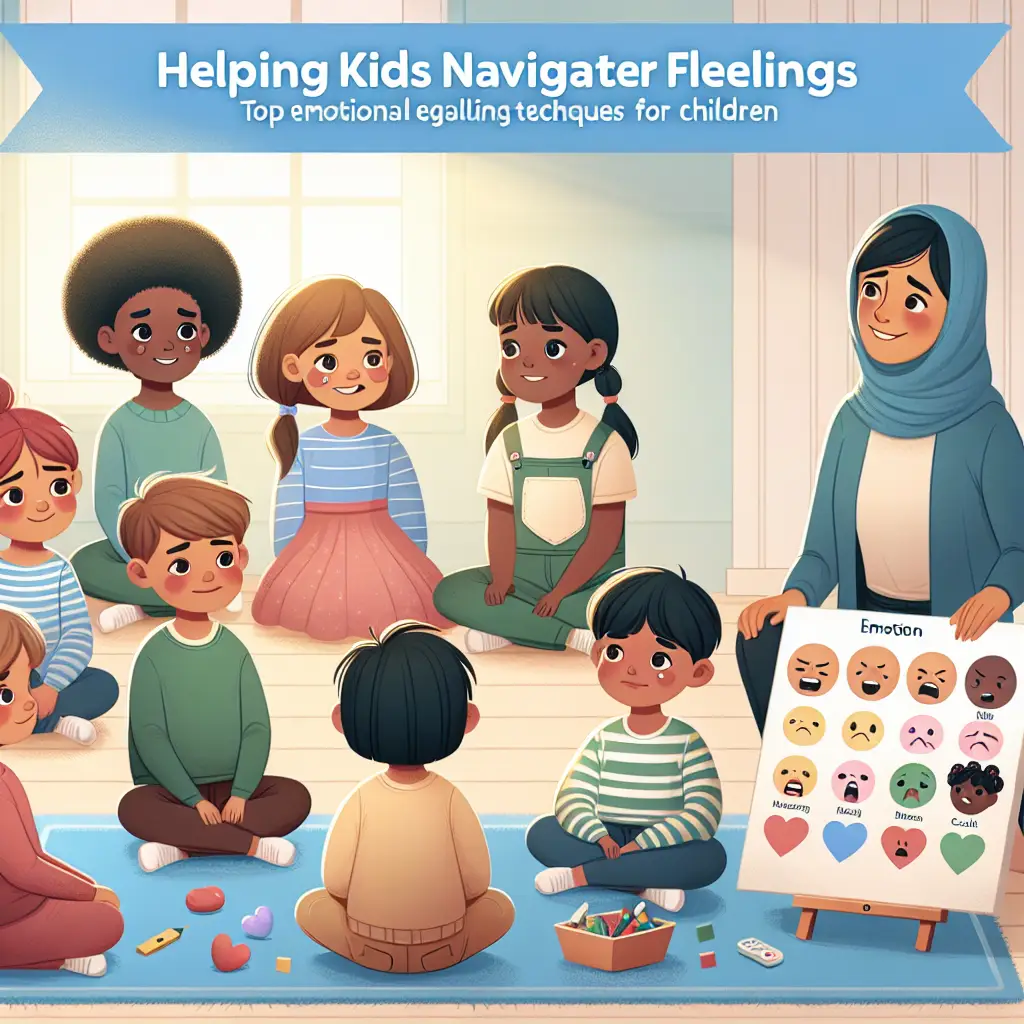
Helping Kids Navigate Their Feelings: Ultimate Emotional Regulation Techniques for Children
Introduction
In today’s fast-paced world, children are faced with a myriad of complex emotions that can be overwhelming at times. From schooling pressures to social dynamics, the landscape of emotional experiences for kids has never been as intricate. As parents, educators, and caregivers, it’s vital to equip our children with the tools they need to understand and manage their feelings. This article delves deep into the essential strategies for helping kids navigate their feelings through effective emotional regulation techniques.
The Importance of Emotional Regulation
Emotional regulation is the ability to monitor, evaluate, and modify emotional reactions in a way that promotes well-being and adaptability. Studies have shown that effective emotional regulation skills can lead to better academic performance, improved relationships, and greater overall happiness. For instance, a 2019 study conducted by the University of Michigan revealed that children who can regulate their emotions are less likely to engage in risky behaviors and are more capable of handling stress.
By focusing on helping kids navigate their feelings, we’re not just teaching them to cope; we’re giving them the tools to thrive. Below, we explore critical techniques that aim to bolster emotional awareness and regulation in children.
Understanding Emotions: The Foundation of Regulation
Before children can regulate their emotions, they must first understand them. This means recognizing feelings as they arise and identifying their causes.
Emotion Identification Chart
| Emotion | Description | Example Situation |
|---|---|---|
| Anger | A strong feeling of displeasure | Losing a game, being treated unfairly |
| Sadness | A feeling of sorrow or unhappiness | Moving away from a friend |
| Joy | A feeling of great pleasure or happiness | Receiving a compliment |
| Anxiety | A feeling of worry or unease | Taking a test |
Case Study: The Emotion Wheel
A school in California implemented an "Emotion Wheel" activity in their classrooms. Teachers encouraged students to use the wheel to identify their emotions throughout the day. This simple yet effective tool allowed children to pinpoint feelings accurately, paving the way for discussions about emotional triggers and responses. By integrating this activity into the curriculum, the school reported a 30% decrease in behavioral issues throughout the term.
By helping kids navigate their feelings through techniques such as the Emotion Wheel, we nurture their emotional intelligence—a skill that serves them throughout their lives.
Practice Mindfulness: The Power of Presence
Mindfulness is gaining popularity as an effective emotional regulation technique. By teaching children to focus on the present moment through awareness and acceptance, we can help them manage their feelings better.
Mindfulness Techniques for Kids
Breathing Exercises: Simple breathing techniques such as "4-7-8 breathing" (inhale for 4 seconds, hold for 7 seconds, exhale for 8 seconds) can help children calm their minds when feelings become overwhelming.
Body Scanning: Encourage kids to lie down and pay attention to different parts of their bodies, identifying where they might be holding tension. This creates a connection between physical sensations and emotional states.
- Guided Imagery: Using storytelling and guided visualization can help children channel their thoughts away from stressful feelings.
Case Study: Mindfulness Workshops in Schools
In a district-wide initiative in Illinois, schools held mindfulness workshops for students and parents. Over six weeks, participants learned breathing techniques, body scanning, and visualization exercises. A follow-up study found an increase in self-reported emotional regulation among students by 40%, showcasing the effectiveness of mindfulness in helping kids navigate their feelings.
Create a Safe Space for Emotions
Creating an environment where children feel safe to express their emotions is crucial for emotional development. This can be achieved through open dialogues, fostering empathy, and utilizing creative expressions.
Tips for Creating a Safe Emotional Environment
- Encourage Open Dialogue: Regularly check in with children about their feelings and encourage them to express themselves without judgment.
- Use Art as Expression: Encourage kids to express their feelings through creative outlets like drawing, painting, or writing.
- Establish a "Feelings Check-In" Ritual: Create a daily ritual of checking in with emotions, perhaps at dinner, to foster ongoing conversation.
Case Study: The "Feelings Jar"
A community center in New York introduced the "Feelings Jar," where children could anonymously submit notes about their feelings throughout the week. During weekly gatherings, one note would be read aloud, and discussions would follow. This not only allowed children to process their emotions but also built a sense of community. Feedback indicated that children felt more connected and supported, improving their emotional regulation skills.
Emotion Coaching: A Skill for Life
Emotion coaching involves parents and caregivers guiding children through their emotional experiences. By modeling emotional awareness and regulation, adults can teach children how to process their feelings effectively.
Steps for Effective Emotion Coaching
- Acknowledge Emotions: Validate children’s feelings by acknowledging and normalizing them.
- Teach Problem-Solving: Assist them in identifying possible solutions or coping strategies.
- Model Healthy Responses: Display healthy emotion regulation in your behavior. Children learn by observing.
Case Study: A Family’s Journey with Emotion Coaching
Consider the example of the Thompson family, who participated in a series of parenting workshops on emotion coaching. They learned to acknowledge their son’s feelings during conflicts rather than dismissing them. Over time, they noticed that their son began to express his emotions more openly, resulting in improvement in family dynamics and his ability to handle setbacks at school.
The Role of Play in Emotional Regulation
Play is a powerful tool in emotional regulation for young children. Through play, children can explore emotions, learn problem-solving skills, and practice coping strategies.
Types of Play for Emotional Exploration
- Role-Playing: Children can assume different characters and scenarios, allowing them to express feelings and practice responses.
- Storytelling: Similarly, storytelling can allow children to narrate experiences through a character’s eyes, offering insight into their feelings.
- Games: Social and board games can help children learn to process competition, loss, and teamwork—all situations that evoke emotions.
Case Study: Therapeutic Play Groups
Research in therapeutic play groups has established their importance in aiding emotional development. One study at a community center found that children who engaged in therapeutic play showed improvement in emotional regulation skills compared to their peers. The structured environment of these groups allowed for controlled exploration of feelings, providing crucial life skills.
Integrating Technology and Resources
In an age where technology is prevalent, we can harness its power to help kids navigate their feelings. Numerous apps and online resources are designed to assist children in emotional regulation.
Recommended Resources
- Mindfulness Apps: Consider apps like "Headspace for Kids" or "Calm Kids," which provide guided meditations specifically for children.
- Emotion Regulation Games: Apps designed to teach coping techniques through interactive play can be both educational and engaging.
Case Study: The Impact of Emotional Literacy Apps
A school in Ohio integrated emotional literacy apps in their curriculum, allowing students to engage with feelings through interactive platforms. Post-intervention reports indicated a marked improvement in emotional identification and regulation, demonstrating how technology can facilitate the process of helping kids navigate their feelings.
Conclusion
In supporting children, our ultimate goal should be to empower them with the skills necessary to navigate their feelings effectively. By understanding emotions, practicing mindfulness, creating safe spaces, coaching through experiences, engaging in play, and utilizing technology, we can provide robust support for our children’s emotional development.
Equipping them with these essential techniques ensures they are better prepared to face life’s challenges. Remember, teaching kids to process their emotions is not just beneficial for their present; it lays the groundwork for a healthier, more resilient future.
FAQs
1. What is emotional regulation?
Emotional regulation refers to the ability to recognize, assess, and manage one’s emotional responses in a healthy and constructive manner.
2. At what age should I start teaching my child emotional regulation?
Teaching emotional regulation can begin as early as preschool. Simple practices like naming feelings and calming techniques can be incorporated into everyday life.
3. How can I tell if my child is struggling with emotional regulation?
Signs that a child might struggle with emotional regulation include frequent tantrums, sudden mood swings, withdrawal, or difficulty managing stress.
4. Are there specific books or resources I can use?
Yes, consider books like "The Color Monster" by Anna Llenas or resources like the "Mindfulness for Kids" workbook, which provide excellent guidance on emotions.
5. Can emotional regulation techniques be taught in schools?
Absolutely. Many schools are now incorporating social-emotional learning (SEL) programs which include lessons on emotional regulation in the curriculum.
In conclusion, helping kids navigate their feelings through various emotional regulation techniques not only aids in their current struggles but also equips them with life skills that resonate throughout their lives. Let’s build a generation of emotionally intelligent individuals who can face challenges with resilience and grace.

















